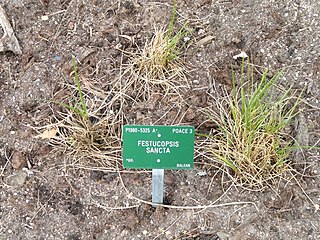
In biological classification, a subfamily is an auxiliary (intermediate) taxonomic rank, next below family but more inclusive than genus. Standard nomenclature rules end botanical subfamily names with "-oideae", and zoological subfamily names with "-inae".

In biology, a subgenus is a taxonomic rank directly below genus.

In botanical nomenclature, a form is one of the "secondary" taxonomic ranks, below that of variety, which in turn is below that of species; it is an infraspecific taxon. If more than three ranks are listed in describing a taxon, the "classification" is being specified, but only three parts make up the "name" of the taxon: a genus name, a specific epithet, and an infraspecific epithet.
In the scientific name of organisms, basionym or basyonym means the original name on which a new name is based; the author citation of the new name should include the authors of the basionym in parentheses. The term "basionym" is used in both botany and zoology. In zoology, alternate terms such as original combination or protonym are sometimes used instead. Bacteriology uses a similar term, basonym, spelled without an i.

In botany and plant taxonomy, a series is a subdivision of a genus, a taxonomic rank below that of section but above that of species.

In taxonomy, a nomen nudum is a designation which looks exactly like a scientific name of an organism, and may have originally been intended to be one, but it has not been published with an adequate description. This makes it a "bare" or "naked" name, which cannot be accepted as it stands. A largely equivalent but much less frequently used term is nomen tantum. Sometimes, "nomina nuda" is erroneously considered a synonym for the term "unavailable names". However, not all unavailable names are nomina nuda.

In biological nomenclature, a syntype is any one of two or more biological types that is listed in a description of a taxon where no holotype was designated. Precise definitions of this and related terms for types have been established as part of the International Code of Zoological Nomenclature and the International Code of Nomenclature for algae, fungi, and plants.
In botany, the correct name according to the International Code of Nomenclature for algae, fungi, and plants (ICN) is the one and only botanical name that is to be used for a particular taxon, when that taxon has a particular circumscription, position and rank. Determining whether a name is correct is a complex procedure. The name must be validly published, a process which is defined in no less than 16 Articles of the ICN. It must also be "legitimate", which imposes some further requirements. If there are two or more legitimate names for the same taxon, then the correct name is the one which has priority, i.e. it was published earliest, although names may be conserved if they have been very widely used. Validly published names other than the correct name are called synonyms. Since taxonomists may disagree as to the circumscription, position or rank of a taxon, there can be more than one correct name for a particular plant. These may also be called synonyms.

In botany, a section is a taxonomic rank below the genus, but above the species. The subgenus, if present, is higher than the section, and the rank of series, if present, is below the section. Sections may in turn be divided into subsections.
In botany, the phrase ordo naturalis, 'natural order', was once used for what today is a family. Its origins lie with Carl Linnaeus who used the phrase when he referred to natural groups of plants in his lesser-known work, particularly Philosophia Botanica. In his more famous works the Systema Naturae and the Species Plantarum, plants were arranged according to his artificial "Sexual system", and Linnaeus used the word ordo for an artificial unit. In those works, only genera and species were "real" taxa.

In zoology and botany, a paratype is a specimen of an organism that helps define what the scientific name of a species and other taxon actually represents, but it is not the holotype. Often there is more than one paratype. Paratypes are usually held in museum research collections.

Priority is a fundamental principle of modern botanical nomenclature and zoological nomenclature. Essentially, it is the principle of recognising the first valid application of a name to a plant or animal. There are two aspects to this:
- The first formal scientific name published for a plant or animal taxon shall be the name that is to be used, called the valid name in zoology and correct name in botany.
- Once a name has been used, no subsequent publication of that name for another taxon shall be valid (zoology) or validly published (botany).
In zoological nomenclature, an available name is a scientific name for a taxon of animals that has been published after 1757 and conforming to all the mandatory provisions of the International Code of Zoological Nomenclature for the establishment of a zoological name.
In biological nomenclature, the principle of typification is one of the guiding principles.

In mycology, a sanctioned name is a name that was adopted in certain works of Christiaan Hendrik Persoon or Elias Magnus Fries, which are considered major points in fungal taxonomy.

Disanthus is a genus containing two species of flowering plants in the family Hamamelidaceae. The type species, Disanthus cercidifolius, was the only known species until 2017, when a second species, Disanthus ovatifolius was described.
In botanical nomenclature, a validly published name is a name that meets the requirements in the International Code of Nomenclature for algae, fungi, and plants for valid publication. Valid publication of a name represents the minimum requirements for a botanical name to exist: terms that appear to be names but have not been validly published are referred to in the ICN as "designations".
An isonym, in botanical taxonomy, is a name of a taxon that is identical to another designation, and based on the same type, but published at a different time by different authors. Citation from that source follows:
When the same name, based on the same type, has been published independently at different times by different authors, then only the earliest of these "isonyms" has nomenclatural status. The name is always to be cited from its original place of valid publication, and later isonyms may be disregarded.

Peridictyon is a name that has been used for a genus of grass with a single species, Peridictyon sanctumnom. inval., native to southern Bulgaria and northern Greece, but a technical problem with the publication means that it is not a botanical name.
Ponerorchis tominagae is a species of flowering plant in the family Orchidaceae, native to Taiwan.










